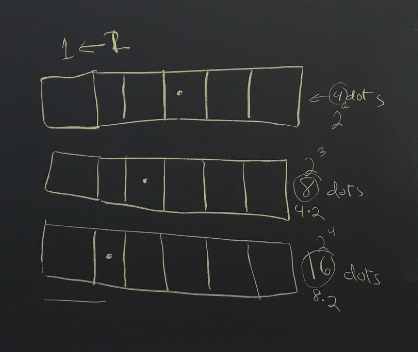In July’s evening CAMI meeting, we met an interesting machine, the “two one” machine, written like this: 1<–2 machine.
Here’s how the machine works:
We can add dots to the box on the far right – as many as we want! Whenever there are two dots in the same box…

…they EXPLODE!

They are replaced by one new dot, in the box to the right.

The process continues until the machine reaches an equilibrium, when no more dots can explode (because there are not two dots in the same box anywhere in the machine).

These machines, based on James Tanton’s series of Exploding Dots lessons from G’day Math, were fun to play with. We spent the next twenty minutes or so exploring these machines in pairs, experimenting with different numbers of dots. Yi was so absorbed that she was reluctant to move on!
But we had to ask, what are these machines for?
Yi showed us that any time we put a power of 2 into the right-most box (2 dots, 4 dots, 8 dots…), our equilibrium resulted in just one dot.

Ann proposed that the machines seemed to create binary numbers. We saw that the machines could be used to generate “codes” by placing a 1 or 0 under each box in the equilibrium:

The group split up again to begin exploring new questions about these machines and the codes they generate.
Olga found a nice way to demonstrate how a “one ten” machine shows place value.

Yi and Aaron continued exploring the powers of 2 in a 2<–1 machine. Ruben explored how you could “work backwards” to find out the original number of dots you had put into a machine. Eric, Audrey, and Ann had a lively debate about a tricky question: is there an easy way to find the code for 324 dots? Eventually we all joined into this conversation. We agreed that the word “easy” was relative.

We were left with many unanswered questions at the end of the meeting. Eric asked, “do the machines just display numbers, or can they be used for operations?”
Everyone was especially curious about what a “2<–3” machine would do. What do you think?
In attendance: Aaron, Ann, Audrey, Carol, Eric, Olga, Ruben, Sophie, Yi
Programs Represented: Brooklyn Public Library, CUNY Start, CUNY Adult Literacy/HSE Program, Hostos Community College


